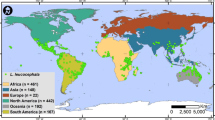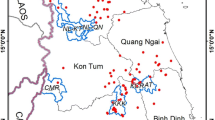Abstract
Six species belonging to the genus Lacerta live in Türkiye. In this study, both present and future potential distribution maps were created based on occurrence data and climatic variables for these six species. Two scenarios for future projections (shared socioeconomic pathways, SSPs,: 245 and 585) and two timeframes (2041–2060 and 2081–2100) were used. The present and future potential distributions of these species were compared. As a result, it was predicted that the distribution ranges in the six species will expand in the future, and this expansion has revealed new environments.













Similar content being viewed by others
Data availability
All data generated or analyzed during this study are included in this published article.
References
Ahmadzadeh F, Flecks M, Rödder D, Böhme W, Ilgaz Ç, Harris DJ, Engler JO, Üzüm N, Carretero MA (2013) Multiple dispersal out of Anatolia: biogeography and evolution of oriental green lizards. Biol J Linn Soc 110(2):398–408
Araújo MB, Rahbek C (2006) How does climate change affect biodiversity? Science 80(313):1396–1397
Arnold EN, Arribas O, Carranza S (2007) Systematics of the Palaearctic and oriental lizard tribe Lacertini (Squamata: Lacertidae: Lacertinae), with descriptions of eight new genera. Zootaxa 1430:1–86
Baran İ, Avcı A, Kumlutaş Y, Olgun K, Ilgaz Ç (2021) Türkiye Amfibi ve Sürüngenleri. Palme Yayınevi, Ankara, Türkiye
Bellard C, Bertelsmeier C, Leadley P, Thuiller W, Courchamp F (2012) Impacts of climate change on the future of biodiversity. Ecol Lett 15:365–377
Booth TH, Nix HA, Busby JR, Hutchinson MF (2014) BIOCLIM: the first species distribution modelling package, its early applications and relevance to most current MAXENT studies. Divers Distrib 20:1–9
Bozkurt E (2022) Ecological niche modelling of the genus Anatololacerta under past, historical and future bioclimatic conditions. Folia Biol 70:45–53
Breiman L (2001) Random forests. Mach Learn 45:5–32
Brown JL, Bennett JR, French CM (2017) SDM toolbox 2.0: the next generation Python-based GIS toolkit for landscape genetic, biogeographic and species distribution model analyses. PeerJ 5:e4095
Bülbül U, Özkan H, Koç H (2022) New locality records of the endemic lizard species, Lacerta pamphylica Schmidtler, 1975 (Squamata: Lacertidae) in Turkey. Russ J Herpetol 29:250–254
Carpenter G, Gillison AN, Winter J (1993) Domain: a flexible modelling procedure for map** potential distributions of plants and animals. Biodivers Conserv 2:667–680
Dayananda B, Bezeng SB, Karunarathna S, Jeffree RA (2021) Climate change ımpacts on tropical reptiles: likely effects and future research needs based on Sri Lankan perspectives. Front Ecol Evol 9:688723
Elith J, Franklin J (2013) Species distribution modeling. In: Levin S (ed) Encyclopedia of biodiversity, 2nd edn. Academic Press, Oxford, pp 692–705
Elith J, Kearney M, Phillips S (2010) The art of modelling range-shifting species. Methods Ecol Evol 1:330–342
Fick SE, Hijmans RJ (2017) WorldClim 2: new 1-km spatial resolution climate surfaces for global land areas. Int J Climatol 37(12):4302–4315
Foden W, Midgley GF, Hughes G, Bond WJ, Thuiller W, Hoffman MT, Kaleme P, Underhill LG, Rebelo A, Hannah L (2007) A changing climate is eroding the geographical range of the Namib Desert tree aloe through population declines and dispersal lags. Divers Distrib 13:645–653
Gómez-Cruz A, Santos-Hernández NG, Cruz JA, Ariano-Sánchez D, Ruiz-Castillejos C, Espinoza-Medinilla EE, Fuentes-Vicente JA (2021) Effect of climate change on the potential distribution of Heloderma alvarezi (Squamata, Helodermatidae). ZooKeys 1070:1–12
Guisan A, Edwards TC Jr, Hastie T (2002) Generalized linear and generalized additive models in studies of species distributions: setting the scene. Ecol Model 157:89–100
Hernandez PA, Graham CH, Master LL, Albert DL (2006) The effect of sample size and species characteristics on performance of different species distribution modeling methods. Ecography 29:773–785
IPCC (2021) Masson-Delmotte V, Zhai P, Pirani A, Connors SL, Péan C, Berger S, Caud N, Chen Y, Goldfarb L, Gomis MI, Huang M, Leitzell K, Lonnoy E, Matthews JB, Maycock TK, Waterfield T, Yelekçi O, Yu R, Zhou B (eds.). Summary for Policymakers (PDF). Climate change 2021: the physical science basis. Contribution of Working Group I to the Sixth Assessment Report of the Intergovernmental Panel on Climate Change. Cambridge (UK): Cambridge University Press. Archived from the original on Aug 19, 2021
IUCN (2023) The IUCN red list of threatened species. Version 2022-2. https://www.iucnredlist.org. Accessed 2 Feb 2023
Kass JM, Vilela B, Aiello-Lammens ME, Muscarella R, Merow C, Anderson RP (2018) Wallace: a flexible platform for reproducible modeling of species niches and distributions built for community expansion. Methods Ecol Evol 9:1151–1156
Kass JM, Pinilla-Buitrago GE, Paz A, Johnson BA, Grisales-Betancur V, Meenan SI, Attali D, Broennimann O, Galante PJ, Maitner BS, Owens HL, Varela S, Aiello-Lammens ME, Merow C, Blair ME, Anderson RP (2023) wallace 2: a shiny app for modeling species niches and distributions redesigned to facilitate expansion via module contributions. Ecography 3:e06547
Kornilios P, Thanou E, Lymberakis P, Ilgaz Ç, Kumlutaş Y, Leaché A (2020) A phylogenomic resolution for the taxonomy of Aegean green lizards. Zool Scr 49:14–27
Laspiur A, Santos JC, Medina SM, Pizarro JE, Sanabria EA, Sinervo B, Ibargüengoytía NR (2021) Vulnerability to climate change of a microendemic lizard species from the central Andes. Sci Rep 11(1):11653
Montagnani C, Casazza G, Gentili R et al (2022) Kudzu in Europe: niche conservatism for a highly invasive plant. Biol Invasions 24:1017–1032
Moreno-Rueda G, Pleguezuelos JM, Pizarro M, Montori A (2012) Northward shifts of the distributions of Spanish reptiles in association with climate change. Conserv Biol 26:278–283
Muscarella R, Galante PJ, Soley-Guardia M, Boria RA, Kass JM, Uriarte M, Anderson RP (2014) ENMeval: an R package for conducting spatially independent evaluations and estimating optimal model complexity for Maxent ecological niche models. Methods Ecol Evol 5:1198–1205
Pearson RG, Raxworthy CJ, Nakamura M, Peterson AT (2007) Predicting species distributions from small numbers of occurrence records: a test case using cryptic geckos in Madagascar. J Biogeogr 34:102–117
Pereira HM, Leadley PW, Proença V, Alkemade R, Scharlemann JP, Fernandez-Manjarrés JF, Araújo MB, Balvanera P, Biggs R, Cheung WW et al (2010) Scenarios for global biodiversity in the 21st century. Science 330:1496–1501
Peterson AT, Soberón J, Pearson RG, Anderson RP, Martínez-Meyer E, Nakamura M, Araújo MB (2011) Ecological niches and geographic disoribuoions. Princeton University Press, United Kingdom
Phillips SJ, Anderson RP, Schapire RE (2006) Maximum entropy modeling of species geographic distributions. Ecol Model 190:231–259
Phillips SJ ARP, Dudík M, Schapire RE, Blair M (2017) Opening the black box: an open-source release of Maxent. Ecography 40:887–893
Quintero I, Wiens JJ (2013) Rates of projected climate change dramatically exceed pastrates of climatic niche evolution among vertebrate species. Ecol Lett 16:1095–1103
Sears MW, Angilletta MJ (2011) Introduction to the symposium: responses of organisms to climate change: a synthetic approach to the role of thermal adaptation. Integr Comp Biol 51:662–665
Shcheglovitova M, Anderson RP (2013) Estimating optimal complexity for ecological niche models: a jackknife approach for species with small sample sizes. Ecol Model 269:9–17
Sillero N, Campos JC, Arenas-Castro S, Barbosa AM (2023) A curated list of R packages for ecological niche modelling. Ecol Model 476:110242
Stockwell DRB, Peters D (1999) The GARP modelling system:problems and solutions to automated spatial prediction. Int J Geogr Inf Sci 13(2):143–158
Thuiller W, Lafourcade B, Engler R, Araújo B (2009) BIOMOD–a platform for ensemble forecasting of species distributions. Ecography 32(369):373
Vaissi S (2021a) Design of protected area by tracking and excluding the effects of climate and landscape change: a case study using Neurergus derjugini. Sustainability 13:5645
Vaissi S (2021b) Potential changes in the distributions of Near Eastern fire salamander (Salamandra infraimmaculata) in response to historical, recent and future climate change in the Near and Middle East: implication for conservation and management. Glob Ecol Conserv 29:e01730
Vaissi S (2022) Response of Iranian lizards to future climate change by poleward expansion, southern contraction, and elevation shifts. Sci Rep 12:2348
Author information
Authors and Affiliations
Contributions
SG, YK, ÇI, and KC conceived and designed research. SG analyzed data and wrote the manuscript. All authors read and approved the manuscript.
Corresponding author
Ethics declarations
Ethics approval and consent to participate
Not applicable.
Consent for publication
Not applicable.
Competing interests
The authors declare no competing interests.
Additional information
Responsible Editor: Philippe Garrigues
Publisher's note
Springer Nature remains neutral with regard to jurisdictional claims in published maps and institutional affiliations.
Supplementary Information
Below is the link to the electronic supplementary material.
Rights and permissions
Springer Nature or its licensor (e.g. a society or other partner) holds exclusive rights to this article under a publishing agreement with the author(s) or other rightsholder(s); author self-archiving of the accepted manuscript version of this article is solely governed by the terms of such publishing agreement and applicable law.
About this article
Cite this article
Gül, S., Kumlutaş, Y., Ilgaz, Ç. et al. Climatic envelopes of the genus Lacerta Linnaeus, 1758 in Türkiye: an application of ecological niche modeling. Environ Sci Pollut Res 30, 56382–56397 (2023). https://doi.org/10.1007/s11356-023-26351-4
Received:
Accepted:
Published:
Issue Date:
DOI: https://doi.org/10.1007/s11356-023-26351-4




